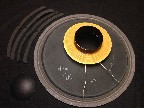
Originally Posted by
RMC

Bonjour Davidpou, and other members who replied here.
You seem to be giving yourself a lot of trouble to confirm the calculated box tuning frequency (Fb). The method I use is probably the simpler one and requires no instruments nor a microphone as suggested by Widget. I use Audio test CD by the Editors of Sound and Vision Magazine made in co-operation with Nippon Columbia, copyright 1993. This Test CD is filled with numerous sound system equipment tests, one of which I use to verify my boxes' Fb, is a frequency response sweep from 20hz to 20 khz. The sweep can be started at any point you want by your CD player.
The test tones are announced by a voice one after the other and each one lasts a few seconds (e.g. 40hz, 35hz, 30hz, etc.). While this CD is playing through your audio sytem/speakers and sweeping the frequencies, you barely touch the driver's cone near the surround with a finger (no pressure on cone) just enough to feel the cone's vibrations as the frequencies going lower are being called. The frequency at which there is the least cone movement or none at all IS the boxe's tuning frequency. Voilà ! As simple as that.
Naturally, there isn't a 29.5hz or a 36.3hz frequency called since it would be an endless process... However, all of them go by in the 20hz-20khz range but frequencies are named by the voice in increments of 5hz in the low end, and in your specific case of 29.5hz the 30hz tone would do the trick. I have used this test CD method for many years with the numerous boxes I've made, including with my pair of JBL 2214H, and it works quite well in confirming my calculated ducted port dimensions/Fb.
Now for the million dollar question: if you insist on confirming say a 32.5hz Fb, how do you proceed with such a CD ? Since the frequencies are ALL swept (20hz-20khz) but only called in increments of 5hz in the bass range, by keeping your finger lightly on the cone ALL the time during the sweep from say 35 to 30hz you WILL feel the absence of vibration at one point in between those two frequencies... This is pretty damn close (just a few hz error margin), though there is no readout to indicate the exact number. If you missed the feeling of non-vibration on your finger or if you're not sure, you can repeat the process from your CD player from anywhere you want on the disc and as many times as you want... You'll see after a few passes how to recognize it easily.
Also, If you look at a cone excursion graph for a vented box in a speaker design software, you will SEE what your finger on the cone is expected to FEEL in terms of vibrations: more above Fb, none or little at Fb and more below Fb...
This test CD also has MANY other goodies, like 20 different spot frequency test signals from 4hz up to 20khz... I doubt this CD would still be available for sale, but you may beg, borrow or steal(?) as they say from someone who has it. Moreover, I suppose that in very large markets such as the European Union where you are or the USA, there MUST be something equivalent available for sale for the audio people.
If not, I wish I could share that CD with others here, but there is a copyright on it and I don't want to be the guy nailed to the cross , have my head on the log ready to be axed or being sued for copyright material theft (violation). Maybe Senior members here, whom I respect and enjoy reading, in addition to being much smarter than me (e.g. Widget, Barry, Earl K, Robh, Ian, Giskard, Ruediger, Horn Fanatic, etc.) have an idea on how to go about sharing that good stuff with others here if there is an interest... I have an idea but keeping it to myself for the time being for the reasons mentioned above, plus others may have an even better one ! BTW I do not know if there is a "lock" on this CD to prevent copying it, never tried . Let's just hope Webmaster/Policeman Don McRitchie wouldn't hit my fingers with his large ruler about this offer... If you would rather discuss in private, my e-mail is on my profile page here.
Salutations,
Richard




 Reply With Quote
Reply With Quote




 when the french freeware used to make the maths was saying that fine tuning was more or less a centimeter around the calculated value...
when the french freeware used to make the maths was saying that fine tuning was more or less a centimeter around the calculated value...




